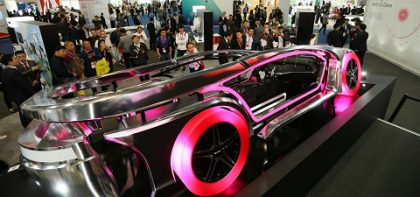 Nowadays, when people talk about automobiles, they no longer simply refer to a four-wheel device with seats that are designed to transport individuals from point A to B. Instead, they increasingly refer to environmentally friendly and intelligent vehicles –– often shared with other users –– that must also provide comfortable, personalized, clean and healthy spaces. The rapid promotion of electric, intelligent, networked and shared vehicles is revolutionizing the automotive industry, introducing new business opportunities and challenges. CHINAPLAS 2019, with the theme of “Innovation is Key to the Future”, is going to present a series of high-tech application solutions for that ever-evolving sector.
Nowadays, when people talk about automobiles, they no longer simply refer to a four-wheel device with seats that are designed to transport individuals from point A to B. Instead, they increasingly refer to environmentally friendly and intelligent vehicles –– often shared with other users –– that must also provide comfortable, personalized, clean and healthy spaces. The rapid promotion of electric, intelligent, networked and shared vehicles is revolutionizing the automotive industry, introducing new business opportunities and challenges. CHINAPLAS 2019, with the theme of “Innovation is Key to the Future”, is going to present a series of high-tech application solutions for that ever-evolving sector.
The Rise of Intelligent Automotive Surface Interiors
The adoption of intelligent networks is making cars “smarter,” which will drive future automotive development while also helping to address existing traffic congestion problems. This trend is changing the very nature of automotive interiors. Looking ahead, nearly every surface of an automobile can be “intelligent”. These smart surfaces will help fulfill consumers’ requirements for automobiles, both aesthetically and functionally. The implementation of intelligent networks relies heavily on technological breakthroughs across various fields. New materials, equipment and manufacturing processes are vital to the development of intelligent interiors, which encompass a combination of traditional accessories and electronic parts. To address users’ strong desire for trendiness and personalization, automakers increasingly will use aesthetically pleasing materials in their vehicles’ interiors.
SuZhou ChengFeng Plastic Co., Ltd will present what it calls “chameleon masterbatch” at CHINAPLAS 2019. The material’s most distinguishing characteristic is that, due to its optical properties, products made of it will exhibit different colors when viewed from different directions. Consumers put great importance on the colors of their automotive interior parts, and this material can be used to manufacture variably colored and highly personalized high-tech interiors.
With interior decoration integrated with electronic components, the car will produce a lot of heat when it is running, so high thermal resistance is key to vehicle interiors. The PPA (6T) resin from Zhejiang NHU Special Materials Co., Ltd. can be used to make intelligent surface interiors, due to its outstanding thermal resistance, low water absorption and high dimensional stability.
Intelligent surface interiors are also integrating additional features, such as haptic feedback, which incorporates the need for electrically conductive materials. Graphene is one of the best conductive materials available, yet manufacturing challenges with the material remain, such as ensuring even dispersion when the graphene is mixed with polymers. At the show, exhibitors will present their approaches to solve this problem. Wuxi JuWang Plastic Material Co., Ltd. has made a technological breakthrough regarding the conductivity of graphene in polymer materials, by which the original properties of the polymer can be maintained while good conductivity is achieved.
The Graphene Polymer Composites R&D Center of Shandong Lutai Holding Group has developed an advanced graphene/PVC composite, in which graphene is grafted to the surface of PVC resin, achieving dispersion on the nanoscale for improved conductivity. CHINAPLAS 2019 will feature brilliant solutions that alter the properties of materials with innovative technologies.
Lighting technology is becoming an increasingly essential part of intelligent automotive surface interiors. Ambient lighting and light-guide strips are gaining acceptance as standard configurations for cars from various large brands. The microwave vacuum drying system developed by Tianjin LEVEL Vacuum Drying Equipment Manufacturing Corporation Ltd. increases the transmission of light-guide strips, thereby improving the lighting system.
Speaking of mood lighting, the light booth, a useful tool for standardized visual color appraisal, is not to be forgotten. BYK (Tongling) Co., Ltd. will present its Byko-spectra pro, a light booth mainly used for visual color evaluation in automotive lighting. With a combination of filtered tungsten-halogen lamps and LEDs, the device can produce lights complying with the highest rendering Class A of CIE 51.2 and guarantee accurate color matching.
Another challenge related to the evolution of intelligent automotive interiors involves how to seamlessly integrate electronic components into surface decorative parts. Kurz Group has put forward a solution for integrating intelligence into automotive interior designs. It uses its In-Mold Decoration (IMD) films and transparent, conductive PolyTC films to produce exquisite and metallic-looking touchscreens that can be hidden when they are in standby mode. IMD and In-Mold Labeling (IML) processes can lower costs and improve productivity for makers of such parts.
Moreover, printing ink and related processes are also important for highlighting the functionalities of intelligent interior components. At CHINAPLAS 2019, Enercon Industries will showcase the latest surface plastics processing equipment used in plasma and flame treatments, which enhances the adhesion and bonding of plastics, glass, metals and composites.
Creating a Healthy & Comfortable ‘Second Home’ with High-tech Green Materials
People are paying more attention to how cars, their “second home”, may affect their health.
The long-glass-fiber-reinforced polypropylene composite developed by Shanghai Pret Composites Co., Ltd. has low odor and volatility, which enhances the use of the material for use in the manufacture of auto parts, such as dashboards, center consoles and car doors.
Guangdong Yizumi Precision Machinery Co., Ltd.’s ReactPro+Hybrid Manufacture System cleverly combines polyurethane (PU) and injection molding materials, improving productivity with a single step, namely in-mold coating, while avoiding the pollution caused by spray painting. The system can produce thinner PU products at a lower cost, and those components also have better appearance and texture, higher scratch resistance, and even some self-healing properties. Moreover, it can be used with 3D printing technology, further expanding the possibilities of injection molding products.
The use of aesthetically pleasing materials, low volatile organic compounds (VOCs), and spray-free materials and processes in automotive interior parts are all intended to ultimately improve overall passenger experience and comfort. Asahi Kasei Corporation will present a concept electric vehicle (EV) – named AKXY, meaning “Asahi Kasei x You (customers)” – that was designed based on the platform of EV manufacturer GLM. The concept EV uses as many as 27 materials, products and integrated systems from Asahi Kasei. The company plans to spotlight technologies that help to replace steel with plastics, assist with lightweighting, and enable the use of “artificial leather” to improve passenger comfort.
BASF (China) Co. Ltd., meanwhile, will display three electric vehicles developed in collaboration with Guangzhou Automobile Group Co. Ltd.’s Research & Development Center. These models adopt several of BASF’s innovative materials and solutions, and have a futuristic design, tailor-made for Chinese car owners with diversified lifestyles.
New Materials & Processes Promote Shared Vehicles, Lightweighting
As the sharing economy becomes increasingly prevalent, health-related concerns related to shared vehicles have aroused heated discussions among consumers.
LOTTE Chemical’s antimicrobial material evermoin® can effectively inhibit bacterial and fungal growth and retain antimicrobial ability and stability, thereby helping to minimize any negative health impacts of having various individuals using the same vehicles.
Shenzhen Wote Advanced Materials Co., Ltd. says its PP+EPDM-TD20 material effectively addresses the problems of surface defect and shrinkage in thin-wall injection molded parts made from traditional plastics. The material has been successfully used in various parts of Geely Bin Yue, including in its 2.0 mm frame and back doors, reducing the total weight by almost 20%. Shared vehicles and lightweighting will be major focuses of those designing and manufacturing future vehicles.
Visitors can enjoy admission discount through online pre-registration from now till May 13, 2019, at an early-bird rate of USD 7.5 for a four-day pass. To pre-register, please “Click Here”













